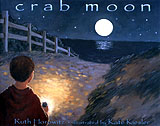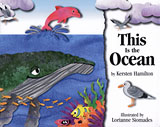 |
By Jolie Jean Cotton
Newly released in paperback, a sobering note opens this award-winning title: "For every blue whale alive today there were once twenty. People hunted and killed so many of them that fewer than 10,000 remain. Now blue whales are protected and hunting them is banned, so in some places their numbers are growing - very, very slowly."
The artist uses pen-and-ink and wash, showing how both elephant and giraffe pale in comparison to the size of a blue whale, the biggest animal that has ever lived on earth. Davies covers the blue whale’s yearly migration, describes its technique for consuming 30 million krill each day and takes us through birthing rituals. Additional facts, found tucked throughout the pages, complement the main story. The typeface expands and contracts to effectively emphasize specific elements of the text.
In a conversational style, the author describes what might a be familiar sight to Hawai‘i residents during our own humpback whale-watching season:
"From time to time, it has to come to the surface to breathe through the blowholes on top of its head. When it breathes out, it makes a great misty puff as high as a house. This is the whale’s blow, and you can see it from far away. You can hear it too - a great poouff. And if you are close enough, you can smell it, as the whale’s breath is stale and fishy!"
The author holds a degree in zoology and has studied humpbacks, sperm whales and blue whales in the open ocean.

 |
| "CRAB MOON" by Ruth Horowitz, Kate Kiesler illustrator, Candlewick Press, ages 4-8, $15.99 |
Lustrous, nearly impressionistic- style oils depict striking East Coast shore scenes in this environmentally sensitive sea story. Written in decisive, melodic language, the story opens with 7-year-old Daniel’s family renting a beach cottage for June’s first full moon. In the middle of the night, the boy follows his mother to the shore to watch hundreds of horseshoe crabs spawning on the beach, as they have for 350 million years.
The next morning Daniel finds tracks left in the sand by the crabs that returned to the ocean. He also discovers a lone crab, stuck upside down, and turns her upright:
"Barnacles and slipper shells covered the crab’s back, like jewels on a crown. She set off down the beach, pausing, and pulling her shell through the sand, quiet as a queen."
Notes on the final page give general horseshoe crab facts.
The author, Ruth Horowitz, says, "I’m drawn to species that get overlooked because they’re not big-eyed or cuddly or cute. I hope this book will show readers the rewards of reaching out to a being that may seem utterly alien at first glance."

-
 |
| "THIS IS THE OCEAN" by Kersten Hamilton, Lorianne Siomades, Boyds Mills Press, ages 3-6, $14.95. |
"This is the ocean,
- Always filled up
- from shore to shore
- like a briny cup,
- Where dolphins play
- and whale pods sing
- of their watery world,
- And mysterious things
- live in the deep,
- where the light
- never reaches
- while waves up above toss
- shells on the beaches."
There’s lots of entertainment and good information packed into this brief, engaging picture book. Through poetic text and enticing illustrations, children follow the cycle of rainfall: The ocean mist rises to the sky, forms clouds, rains back to earth’s streams and rivers and flows, once again, to the ocean.
Brightly colored two-dimensional art depicting cheerful sea creatures blends flawlessly with the author’s buoyant choice of words. The book closes with a short paragraph that concisely describes the water cycle, complemented by simple explanations of the oceans, mist, clouds, rain, streams and rivers.
The author has published many books for children, including "The Butterfly Book: A Kids Guide to Attracting, Raising and Keeping Butterflies."
[back to top] |
 |

 The Great Index to Fun
The Great Index to Fun
